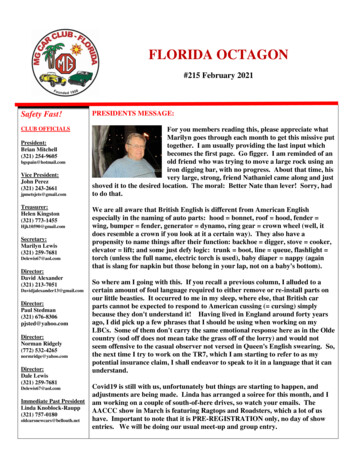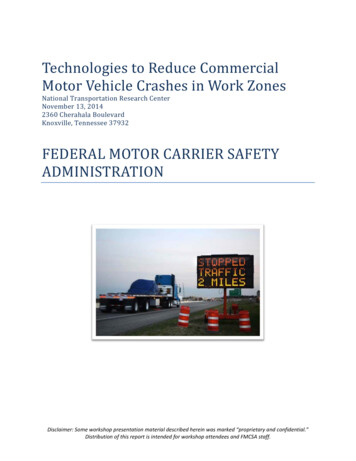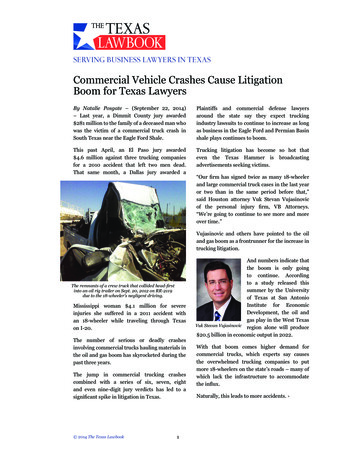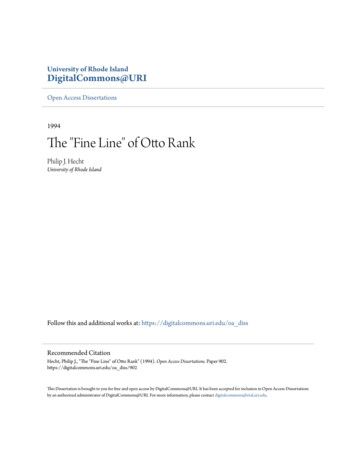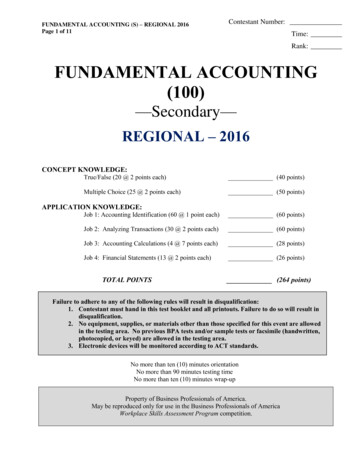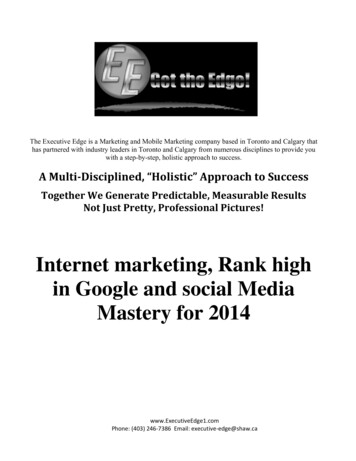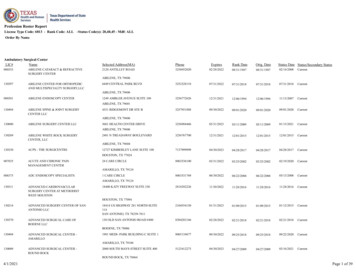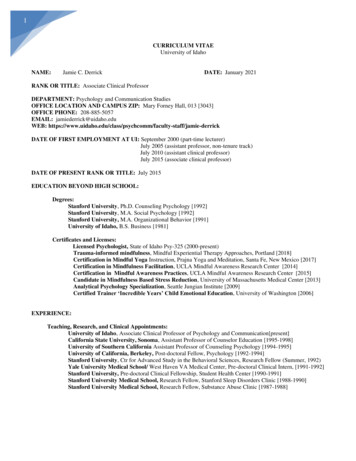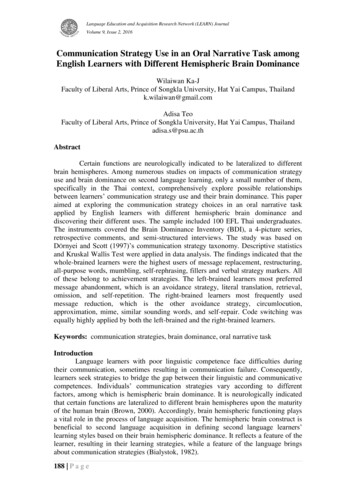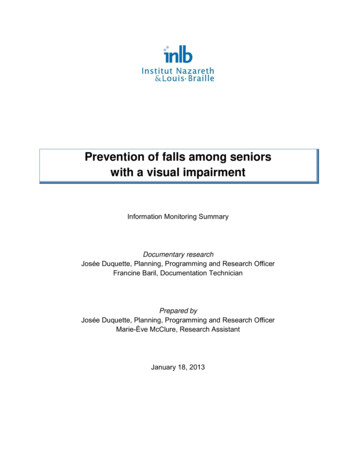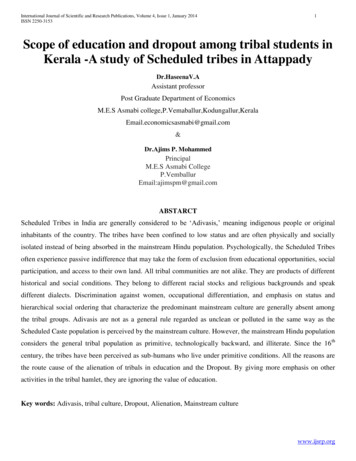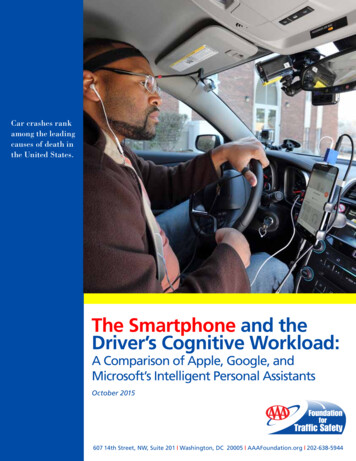
Transcription
Car crashes rankamong the leadingcauses of death inthe United States.The Smartphone and theDriver’s Cognitive Workload:A Comparison of Apple, Google, andMicrosoft’s Intelligent Personal AssistantsOctober 2015607 14th Street, NW, Suite 201 Washington, DC 20005 AAAFoundation.org 202-638-5944
TitleThe Smartphone and the Driver’s Cognitive Workload: A Comparison of Apple, Google, andMicrosoft’s Intelligent Personal Assistants. (October 2015)AuthorDavid L. Strayer, Joel M. Cooper, Jonna Turrill, James R. Coleman, and Rachel J. HopmanUniversity of UtahAbout the SponsorAAA Foundation for Traffic Safety607 14th Street, NW, Suite 201Washington, DC 20005202-638-5944www.aaafoundation.orgFounded in 1947, the AAA Foundation in Washington, D.C. is a not-for-profit, publiclysupported charitable research and education organization dedicated to saving lives bypreventing traffic crashes and reducing injuries when crashes occur. Funding for this reportwas provided by voluntary contributions from AAA/CAA and their affiliated motor clubs,from individual members, from AAA-affiliated insurance companies, as well as from otherorganizations or sources.This publication is distributed by the AAA Foundation for Traffic Safety at no charge, as apublic service. It may not be resold or used for commercial purposes without the explicitpermission of the Foundation. It may, however, be copied in whole or in part anddistributed for free via any medium, provided the AAA Foundation is given appropriatecredit as the source of the material. The AAA Foundation for Traffic Safety assumes noliability for the use or misuse of any information, opinions, findings, conclusions, orrecommendations contained in this report.If trade or manufacturer’s names are mentioned, it is only because they are consideredessential to the object of this report and their mention should not be construed as anendorsement. The AAA Foundation for Traffic Safety does not endorse products ormanufacturers. 2015, AAA Foundation for Traffic Safety
Executive SummaryThe goal of this research was to examine the impact of voice-based interactions using threedifferent intelligent personal assistants (Apple’s Siri, Google’s Google Now for Androidphones, and Microsoft’s Cortana) on the cognitive workload of the driver. In twoexperiments using an instrumented vehicle on suburban roadways, we measured thecognitive workload of drivers when they used the voice-based features of each smartphoneto place a call, select music, or send text messages. Cognitive workload was derived fromprimary task performance through video analysis, secondary task performance using theDetection Response Task, and subjective mental workload. We found that workload wassignificantly higher than that measured in the single-task drive. There were alsosystematic differences between the smartphones: The Google system placed lower cognitivedemands on the driver than the Apple and Microsoft systems, which did not differ in thisregard. Video analysis revealed that the difference in mental workload between thesmartphones was associated with the number of system errors, the time to complete anaction, and the complexity and intuitiveness of the devices. Finally, surprisingly highlevels of cognitive workload were observed when drivers were interacting with the devices “on-task” workload measures did not systematically differ from that associated with amentally demanding memory/math OSPAN task. The analysis also found residual costsassociated with using each of the smartphones that took significant time to dissipate. Thedata suggest that caution is warranted in the use of smartphone voice-based technology inthe vehicle because of the high levels of cognitive workload associated with theseinteractions.1
IntroductionDriver distraction, operationalized here as “the diversion of attention away from activitiescritical for safe driving toward a competing activity” (Regan, Hallet, & Gordon, 2011; seealso Engström, et al., 2013; Regan & Strayer, 2014), is increasingly recognized as asignificant source of injuries and fatalities on the roadway. The U.S. Department ofTransportation estimated that in 2013, 3,154 people were killed and an additional 424,000were injured in motor vehicle crashes involving driver distraction on U.S. roadways(Pickrell, 2015); however, the report acknowledged limitations to the way the that the datawere collected and suggested that the actual number is likely much higher. In support ofthis, a recent report by the AAA Foundation for Traffic Safety found that 58% of all crashesamong teenage drivers could be attributed to driver inattention (Carney et al., 2015).The National Highway Safety Traffic Administration (NHTSA) is in the process ofdeveloping voluntary guidelines to minimize driver distraction created by electronic devicesin the vehicle. There are three phases to the NHTSA guidelines. The Phase 1 guidelines,entered into the Federal Register on March 15, 2012, address visual-manual interfaces fordevices installed by vehicle manufactures. The Phase 2 guidelines, scheduled for releasesometime in 2015, will address visual/manual interfaces for portable and aftermarketelectronic devices. Phase 3 guidelines (forthcoming) will address voice-based auditoryinterfaces for devices installed in vehicles and for portable aftermarket devices.In order to allow drivers to maintain their eyes on the driving task, nearly every vehiclesold in the US and Europe can now be optionally equipped with a voice-based interface.Using voice commands, drivers can access functions as varied as voice dialing, musicselection, GPS destination entry, and even climate control. Voice activated features mayseem to be a natural development in vehicle safety that requires little justification. Yet, alarge and growing body of literature cautions that auditory/vocal tasks may haveunintended consequences that adversely affect traffic safety.In 2013, we reported on a methodology for assessing cognitive distraction in the vehicle(Strayer et al., 2013). Converging measures of mental workload from primary andsecondary task performance, physiological recordings, and self-reports, were used todevelop a rating system for cognitive distraction where non-distracted single-task drivinganchored the low-end (Category 1) and the mentally demanding Operation Span (OSPAN)task anchored the high-end (Category 5) of the scale.In 2014, we reported on an extension of our earlier methods designed to measure cognitiveworkload in six 2013 vehicles equipped with voice-based technology that facilitates tuningthe radio and placing outgoing calls. We found striking differences in the workload ratingsassociated with the different systems, with the Toyota system having a workload ratingroughly equivalent to listening to a book on tape and the Chevy system having one of thehighest workload ratings we have observed for any in-vehicle task. Clearly, the userinterface had a large impact on driver workload, frequency of errors, and time to completethe various tasks.One alternative to using a vehicle’s embedded voice controls for many common tasks is thesmartphone. The advantage of these systems is that they are already commonly available,2
they are constantly being updated, they are familiar to drivers, and they offer nearlylimitless capabilities. In this report, we present the findings of two on-road drivingexperiments designed to measure the cognitive workload associated with interactions usingthree different intelligent personal assistants (Apple’s Siri, Google’s Google Now forAndroid phones, and Microsoft’s Cortana) on the cognitive workload of the driver 1 .The selected tasks and experimental structure were designed to extend our prior workusing embedded vehicle systems (Cooper et al., 2014). In the first experiment, weevaluated the cognitive demand of common voice interactions while driving. In the secondexperiment, we evaluated the cognitive demands associated with sending voice-based textmessages. How do the different smartphone systems compare with each other and whatare the bases for any observed differences in the cognitive workload experienced by thedriver? How do these smartphone systems compare with embedded systems found in thedifferent OEM systems?In our discussions with representatives from Google, they indicated that: “the Google voice systemthat you are planning to test has never been promoted for in-vehicle use by Google. And though weunderstand that some users may engage in this type of activity, Google does not encourage thisbehavior.”13
MethodsExperiment 1ParticipantsFollowing approval from the Institutional Review Board, participants were recruited byword of mouth, advertisements placed on online local classified websites, and flyers postedon the University of Utah campus. They were compensated 60 upon completion of the 2.5hour study. Data were collected from February 27th 2015 through April 14th of 2015.Thirty-one subjects participated in Experiment 1 (16 males, 15 females). The youngestparticipant was 21 and the oldest was 68 years old, with an average age of 42. The Divisionof Risk Management Department at the University of Utah ran a Motor Vehicles Recordreport on each prospective participant to ensure participation eligibility based on a cleandriving history (e.g., no at-fault accidents in the past five years). In addition, followingUniversity of Utah policy, each prospective participant was required to complete a 20minute online defensive driving course and pass the certification test. Participants wereselectively recruited to balance gender across the eligible age range. Everyone whoparticipated in this research owned a smartphone and 64% reported using their phoneregularly while driving. Participants reported between 5 and 52 years of driving experiencewith the average being 26 years. Additionally, participants reported driving an average of200 miles per week over 8.5 hours. All participants were recruited from the greater SaltLake area and spoke with a western US English dialect.DesignA 5 (condition) x 3 (age groups) mixed within and between subjects design was used. The 5within-subject conditions were: Single-task, Apple’s Siri, Google’s Google Now, Microsoft’sCortana and the OSPAN task. The 3 between-subject age groups were: ages 21-34, ages 3553, and ages 54-70. Each participant experienced each of the five experimental conditionsin a counterbalanced order. During interactions with the intelligent personal assistants,participants completed 2 number dialing tasks, 2 contact calling tasks, and 4 musicselection tasks presented in 2 blocks.In addition, some of the dependent measures used in the study allowed the differentiationof on-task and off-task performance during the three intelligent personal assistantconditions. For these analyses, an 8(condition) x 3(age group) design was used.Materials and EquipmentAccess to intelligent personal assistants engineered by Apple, Google, and Microsoft, wasprovided using an Apple iPhone 6 with iOS 8.2 (Build 12D508), a Google Nexus phonerunning Android 5.0.1 (Build LRby22C), and a Nokia Lumia 635 running Windows 8.1 (O.S.Version 8.10.12400.899), respectively. Identical music and contacts libraries were loadedon to each of the phones, providing the basis for the task evaluations.An Apple “EarPods with Remote and Mic” was attached to each of the phones. The rightspeaker lead was inserted into participants’ right ear and the left speaker lead was taped tothe microphone input of the video collection system. A small button, attached to the cord ofthe headphones controlled the activation / deactivation of each of the three intelligent4
personal assistants. This setup was selected because, at the time of testing, the single-earsystem was legal in all 50 states. By using identical headphones we could ensure that anypotential differences between the phones were related to characteristics of the verbalinterface, and not potential differences in audio quality, microphone sensitivity, or otheraspects of the physical interface.Cellular phone service for all three systems was provided by T-Mobile. Excellent cellcoverage (4-5 bars) was available during the entire drive on all phones. Phones weresecured to the center console, just to the right of the steering wheel, using a universalsuction mount that securely held each of the phones during interactions.The vehicles used in the experiment were a 2015 Chevy Malibu with an automatictransmission and a 2015 Chrysler 200c with an automatic transmission. 2 Participantswere familiarized with the vehicle and allowed to adjust the seat and mirrors before thestudy commenced. Participants drove the vehicle for approximately 20 minutes before theexperiment began.Two Sony Action Cams were used to collect video and audio feeds during experimentation.One was mounted to the front windscreen, just under the rear-view mirror, and faced thedriver. The other was mounted between the two front seats via a rigid pole attached to thepassenger seat headrest; it captured a view of the vehicle interior, including the screen ofeach phone, as well as the forward roadway. The two video feeds were synchronized forlater video analysis.During all phases of testing, participants wore a head-mounted Detection Response Task(DRT) device that was manufactured by Precision Driving Research. The DRT protocolfollowed the specifications outlined in ISO WD 17488 (2015). The device consisted of anLED light mounted to a flexible arm that was connected to a headband, a micro-fingerswitch attached to the participant’s left hand, and a dedicated microprocessor to handle allstimulus timing and response data. The light was positioned in the periphery of theparticipant’s left eye (approximately 15 to the left and 7.5 above the participant’s left eye)so that it could be seen while looking at the forward roadway but did not obstruct their viewof the driving environment. The configuration used in this research adh
607 14th Street, NW, Suite 201 Washington, DC 20005 AAAFoundation.org 202-638-5944 Car crashes rank among the leading causes of death in the United States. The Smartphone and the Driver’s Cognitive Workload: Title The Smartphone and the Driver’s Cognitive Workload: A Comparison of Apple, Google, and Microsoft’s Intelligent Personal Assistants. (October 2015) Author David L. Strayer .Cited by: 10Publish Year: 2015Author: Rachel J. Hopman, James R. Coleman, Jonna Turrill, Joel M. Cooper, David L. Strayer
